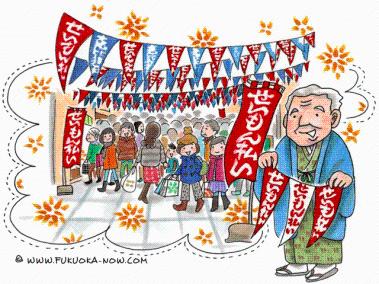Hakata Culture vol.105
Seimon-barai: Hakata’s Annual Bargain Sale

Every year in mid-November, the shopkeepers in Fukuoka’s shopping arcades hold a bargain sale called seimon-barai. To show their appreciation, shopkeepers offer their wares at bargain-basement prices, and the annual sale is considered a sign of the coming winter. Rihei Yahiro, the proprietor of a pickle shop in Shimokawabata called Kinzando, began the practice in the Meiji Era. Considering that bargain sales, which are commonplace now, did not exist back this, this was quite an innovative move.
Yahiro learned of the practice of seimon-barai when he went to Osaka on business. There he saw people flocking to the bargain sale at the Ebisu Ichi market, and began to wonder if he couldn’t do something similar in Hakata. Yahiro approached the city’s kimono merchants about the idea, but back then, the only time you would ever see a bargain sale was when someone’s shop was going out of business. The negotiations were tough, but in the end 27 shopkeepers agreed to cooperate, and the first seimon-barai was held in 1879 (Back then, it was known as the seimon-bare.)
The sale grew larger in size every year, and aside from a stint during the war when it was suspended, it has continued to the present day. Initially, the seimon-barai was only held in the Kawabata shopping arcade, but after the war it spread to Shintencho and other shopping streets. Now, the large department stores in Tenjin and Hakata also participate in the event, which goes by the name of Fukuhaku Seimon-barai, and the various merchants have added their own unique flair to the sale.
After making the bargain sale a reality, Yahiro put several other ideas into practice: He built a leisure facility along the river in Sumiyoshi in an effort to recreate Tokyo’s Mukojima amusement park in Fukuoka and erected a 30-meter octagonal tower in Nakasu. Later, in 1917, he started the Nakagawa fireworks festival, which continues to this day—albeit in Ohori Park—as the Nishinippon Ohori Fireworks that is held every year in August.
博多のアイデアマンが始めた「せいもん払い」
毎年11月中旬になると、福岡・博多の商店街では「せいもん払い(誓文払い)」と呼ばれる大売り出しが行われます。博多商人の感謝の気持ちを込めた大安売りで、博多に冬の訪れを告げる風物詩としても知られています。誓文払いは博多下川端で漬物店「金山堂」を営んでいた八尋利兵衛(やひろりへい)が始めたもので、今のようなバーゲンがなかった明治時代には、たいへん斬新なアイデアでした。
利兵衛が商用で大阪に出かけた際、蛭子市(えびすいち)の誓文払いが大繁盛しているのを見て、「博多でもこの賑わいが再現できないか」と考えました。利兵衛は博多の呉服商に呼びかけましたが、当時の大売り出しといえば店が倒産したときに行なうもの。交渉は難航しましたが、何とか27店の協力を取り付けて、1879(明治12)年暮れに初めての「誓文晴れ」(せいもんばれ=当時の名称)を実現します。
その後は年々規模を大きくして、戦時中に一時中断した時期をのぞき、今に受け継がれています。もともとは川端商店街で行われていた誓文払いですが、戦後は新天町商店街など他の商店街にも広まっていきました。今では天神・博多の百貨店なども参加して、それぞれの団体が工夫を凝らしながら「福博せいもん払い」として盛大に行われています。
利兵衛はその後もさまざまなアイデアを実践していきます。東京・向島遊園地の賑わいを再現しようと住吉の河原にレジャーランドを開発したり、中洲に高さ30メートルの八角形の高層楼を建てたり。さらに1917(大正6)年には那珂川で花火大会を始めました。この花火大会は会場を中央区大濠公園に移して、毎年8月の「西日本大濠花火大会」として続いています。

